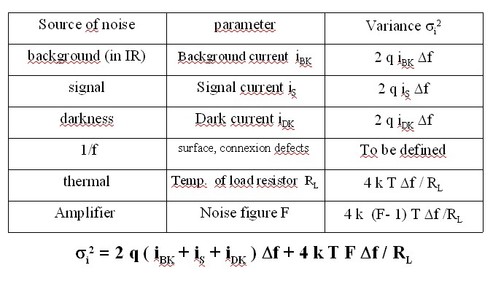
Sources of noise in an electro-optical sensor
First of all, the detector of an EO sensor is a noisy electrical source because the photon rate of arrival upon its sensitive area is not constant in time. This fluctuation induces a fluctuation in the electron delivery rate, or shot noise in the output. The spectral density of the corresponding variance is given by the Shottky formula, below, wher i represents the average output current from the detector :
Besides that, because of the thermal agitation of its electrons, the load resistor of the detector is another source of noise, or thermal noise. Its spectral density with respect to temperature T is given by Johnson formula :
in which kB is Boltzmann's constant, and RL the detector load resistor
There are other sources of noise, from the electronics, which must also be taken into account : a large part of it may come from the preamplifier and, generally to a lesser degree, from the next stages (reset noise, digitization noise). In order to appreciate properly their influences, all these origins of noise are by convention evaluated at the same point as the signal itself, i.e. at the immediate outset of the detector. Each electronic noise (at pre-amplifier, amplifier, filters, reset, digitization stages) is brought back to that point by its noise figure F, with respect to the first electronic stage and its spectral density evaluated there, such as th preamplifier noise, below :
All noise sources are uncorrelated so that the variance of the total noise current is the sum of the variances of the contributing noise currents :
hence the following expression for the global variance of the output current at the outset of the detector as defined inside the noise equivalent electronic bandwidth Δf :
Usually, some sources of noise will emerge as more important than the others : the main origin of noise varies with respect to the spectral domain of the sensor, the mode of detection (direct or heterodyne) and the ambient light environment (darkness, daylight, level of stray light,...). The table of figure 13 lists some of the main origins of noise in some usual cases.
